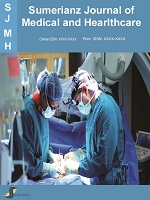Sumerianz Journal of Medical and Healthcare

Online ISSN: 2663-421X
Print ISSN: 2706-8404
Quarterly Published (4 Issues Per Year)
Journal Website: https://www.sumerianz.com/?ic=journal-home&journal=31Archive
Volume 6 Issue 2 (2023)
Comparative Studies on Chemical Profile of Red Soko (Celosia Trigyna) and Green Soko (Celosia Argentea)
Authors : Jacob Olalekan Arawande ; Christianah Olusola Ayodele ; Abraham Olasupo Oladebeye ; Babawale Peter Olatunji ; Ayodeji Temitope Adesuyi ; Olajubu Ayotunde Karimu
DOI : doi.org/10.47752/sjmh.62.13.19
Abstract:Chemical profile of leafy vegetables enable researchers to affirm the constituents present in them as well as knowing their possible usefulness for consumption and medicinal applications. Red and green soko were obtained, rinsed in water and cut into smaller pieces, air dried, grounded and sieved to give 40mm mesh size powder. The powdered samples were analyzed for proximate composition and mineral contents using standard methods. The antioxidant properties such as reducing power, ferrous ion chelating activity 2,2- diphenyl-1picrylhydrazyl (DPPH) radical scavenging activity and 2,2-azinobis (3-ethylbenzothiazoline-6-sulphonic acid (ABTS) of samples were determined. Red soko had the higher value of crude lipid (2.36 ± 0.06%), ash content (16.45 ±0.15%), protein (17.06 ±0.06%), and dry matter (89.74 ±0.24%) while green soko had higher value of moisture content (10.86±0.33%), crude fibre (13.66±0.20%), carbohydrate (54.81.81±0.21%) and energy value (297.38±0.89 Kcal/100g). Red soko had the higher values of Mg (25.16 ± 0.22 mg/kg), Fe (2.86±0.05 mg/kg), Zn (0.10 ± 0.02 mg/kg), Mn (0.56 ±0.08 mg/kg), and Cu (0.20 ±0.01 mg/kg) while green soko had higher value of Ca (180.16 ±1.00 mg/kg), Na (73.44 ±0.00 mg/kg), K (694.14 ± 0.96 mg/kg), Pb (0.23 ±0.00 mg/kg) and Se (0.20 ±0.03 mg/kg). Green soko had higher value of ferric reducing antioxidant power (0.36±0.04%), Fe2+ Chelating Activity (4.46±0.09%), DPPH radical scavenging activity (11.75±0.74%) and ABTS+ Radical Scavenging Activity (10.18±0.44%) than red soko. The antioxidant properties (TRAP, Fe2+, DPPH and ABTS+) of green soko were higher than red soko. Green soko is richer in antioxidant properties than red soko.
Unpacking the Factors of Overweight/Obesity in Type 2 Diabetes: What You Need to Know: Review Article
Authors : Fatma Ibrahim Abdel-latif Megahed
DOI : doi.org/10.47752/sjmh.62.8.12
Abstract:The rising prevalence of overweight and obesity among type 2 diabetic patients has become a major concern for healthcare professionals. Obesity and overweight are significant risk factors for the development of type 2 diabetes. In fact, it is estimated that over 90% of individuals with type 2 diabetes are either overweight or obese. Obesity and type 2 diabetes are becoming increasingly prevalent worldwide, leading the World Health Organization to label them as pandemics of the 21st century. In this article, we will explore the different factors that contribute to overweight/obesity among individuals with type 2 diabetes. Genetics and family history play a crucial role in the development of obesity. Lifestyle factors, such as poor dietary habits, physical inactivity, sedentary behavior and poor sleep quality and duration are also a significant risk factor for obesity.


